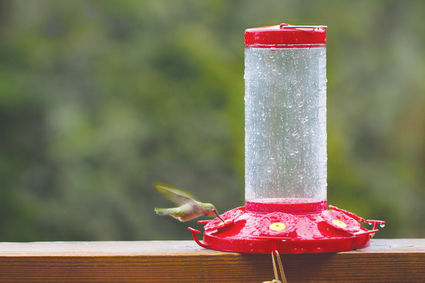Hummingbirds returning from winter homes
April 2, 2020

Metro Creative Photo
A HUMMINGBIRD feasts on homemade nectar, a reliable food source for the birds that migrate to Montana in the spring.
April is the time of year Montanans usually start to see hummingbirds migrate north for the spring. Hummingbirds have two migrations every year in the spring and the fall as they fly to and from their winter homes in Mexico and Central America.
According to Montana Fish, Wildlife and Parks (FWP), Montana has the honor of seeing the migration of the calliope hummingbird. "Perhaps the most heroic migration from Montana is that of the calliope hummingbird, the world's smallest migrating bird." Along with the calliope, the state's western and central regions also see the migration of several other hummingbirds including Anna's, Montana's rufous, broad-tailed, and black-chinned, which is the state's most commonly seen.
Males are the first to migrate north, while females grace us with their presence around 14 days later. Hummingbirds have been known to have the ability to alter their routes according to the resources available to them. While weather conditions play a strong role in their food source, there are several native plants they are most attracted to. There are also several plants you can add on your own to not only attract hummingbirds to your yards; but to help feed them in a part of the year where nectar can be scarce. Montana native plants that will produce a natural source of nectar include: wax currant, blue virgin's bower, serviceberry, golden currant, Oregon grape, hawthorn, Jacob's ladder and shrubby penstemon.
The Hummingbird Society has said these fascinating little creatures are attracted to blossoms in the colors of red, orange, yellow and blue. They usually go after tubular blossoms because, "the shape limits insects' access to the nectar inside." Chinese Lanterns, fragrant Columbine, Honeysuckle, Bergamot and Salvia Sage are all plants you can bring in on your own that will also provide a natural source of nectar.
Make Your Own Nectar
The diets of hummingbirds consist of two different types of sources. An energy source which would be nectar, and a protein source which typically consists of small insects. Hummingbirds will gladly take an artificial source of nectar from homemade hummingbird feeders. Providing homemade nectar will give you the chance to observe these migratory birds in your own backyard, as well as giving them a reliable source of food.
Something to keep in mind when feeding hummingbirds; they are known to be territorial with their favorite feeders. It would be ideal to set up several feeders around your yard.
Ingredients
1 cup white cane sugar. Do not substitute honey or artificial sweetener for cane sugar.
4 cups spring water
Dissolve the sugar in boiling water and let cool completely before transferring to a feeder. Do not add red food coloring.
If bees are a problem, use a 5-to-1 ratio of water and sugar. This will help reduce the bee's interest.
Homemade nectar can be stored in the refrigerator for up to one week, if needed.
Take all feeders down in the fall, wait until you haven't seen any feeding for three weeks. This will help reduce the risk of late migrants.
Empty, clean, and refill the feeder every three days or two days if weather is above 90 degrees, and immediately if the nectar is looking cloudy. Warmer weather may cause the nectar to spoil which can cause hummingbirds to become sick.






Reader Comments(0)